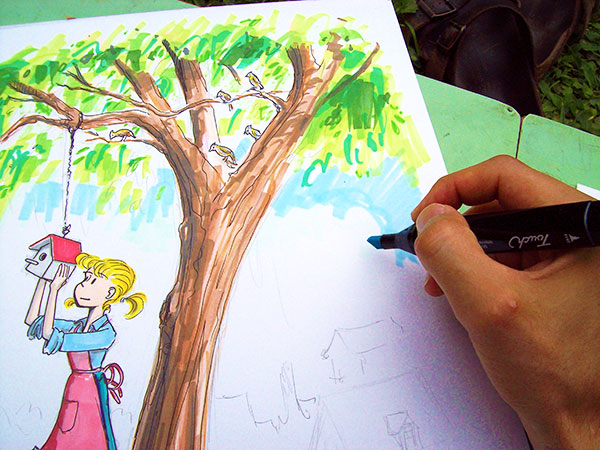With Summer properly here, I figured I'd write a piece on drawing in the great outdoors.

Here's my little portable drafting board. I've written about it before, but I realized that I'd never shown any pictures of it. Given that I use it all the time, I thought it might be neat to share.
As any artist will tell you, the idea of working outdoors in the sun is a very appealing idea. Sitting under a nice shade tree to sketch in the fresh air? What could be more inspiring?
But then they will try and quickly discover that there's a reason we build houses and put our studios inside them. Wind, rain, bugs and even days with too much sunlight can make it challenging to draw outdoors. But one of the biggest challenges is simply that of trying to carry all your tools and papers with you; -without losing your pens in the grass, without your papers getting bent or dirty and without the whole thing being awkward to carry on a bus or bike.
Now, in my school days, I was a large proponent of the Big Hardcover Sketchbook. —The kind you can throw into a backpack and go, and when you want to draw, you can whip out, open up, and there you are, your drafting board is instantly in front of you with a fresh sheet of paper all nicely laid out. I recommend them to anybody who wants to learn how to draw. Nothing beats them for convenience. The only problem is that they are limited. With a sketch book, an artist is restricted to using the paper in the book, which isn't usually the best stuff. If you want to paint in them, the paper can soak through and get things messy. Past pictures you might be fond of are likely to get dirty and smudged over time. So really, sketch books are good for sketching in. . , and that's about it. (I guess they call them 'sketch books' for a reason). If you want to take your more serious work with you, then you need a proper art bag.
The one thing that art portfolio bags are designed to do, that they do very well, is protect your paper while you carry it around town. Every artist can benefit from an art portfolio bag. The problem is that a portfolio bag isn't altogether the most convenient shape. They tend to be awkward in the way they take up space. You can't carry them like a backpack, so they're hopeless when you're on you bike. When you put them down, they need to lean against something or they fall over and generally. . , well, art bags are just kind of annoying. Also. . , while they are good at transporting paper after you've left your studio, they don't offer any help once you arrive wherever you were going. So unless you're heading to another place which has another decent work surface, then you're stuck having to solve that problem and your portfolio bag isn't going to help at all. Unlike the noble sketch book, they do not offer that one vital feature every artist appreciates: a nice firm surface to draw on!
If only. . , I thought, somebody would just make an art portfolio bag which was ALSO a drafting board. . . How hard could that be?
Well, as I discovered. . , not hard at all.
The construction is pretty simple. Two matching halves, each a shallow wooden box, held together with a pair of brass hinges and closed up with a brass latch on the other side. When closed, the box is an inch and a half thick, big enough inside to hold sheets of 11" x 15" paper. (In retrospect, I think I should have made it big enough to hold sheets of 11" x 17", but at the time I was trying to make the whole thing small enough to fit inside a standard backpack, so compromises were made.)


I used a thin laminate plywood, 3/16" thick, and using some two-sided carpet tape, I stuck down some "Borco" rubberized drafting board skin. (That stuff is simply the BEST work surface in the industry. Ask for it at your local art store if you own a drafting board. It's worth every penny!)

Normally, my pencil case will also fit inside, but today I had two full decks of bristol board, so it wouldn't quite go.


That little nut and bolt I keep in my pencil case. It's used to lock open the drafting board to full size.


Here's the board in the locked-open position. The big seam down the middle means you can't draw with abandon on a sheet of thin paper because your pencil will trip over the seam, but when using bristol board, it's surprisingly easy to ignore. In any case, it makes for a fairly large work surface right out of your backpack. I do find, however, that I rarely need or want to do this as the box is nearly always big enough to draw on when closed unless I'm doing a really big piece.


When fully open, there's plenty of space for all my bits and pieces. I can sit with it in my lap quite comfortably, though the downside is that when it is fully open like this, all loose papers have to be taken out of the box and put somewhere safe, or kept on top of the board. This is another reason I prefer to work with it closed and just take out the piece I happen to be working on. It's also good to have a few bits of masking tape available to keep things from blowing around if the wind picks up.

I recently picked up a set of art markers. This little bag keeps them together and they can squat comfortably beside me for easy access.

Art markers are really fun to use. Here are some pictures of some of my latest designs. . .





I'm planning on painting larger versions of these. Markers are nice, but they also look a little un-finished. Not like a real painting. You can see the difference in the little piece below. . .

The only thing about paint is that it can be a whole lot messier than markers. I did the above picture of Heath and Varkias away from my my studio, but I needed to take with me a paint brush and an old jam jar filled with water. I used a folded piece of scrap bristol board for a pallet and it worked quite well, but it wasn't as easy to do as it is at home. It was fun though. Always make sure you have a few sheets of paper towel!
So anyway. . , that's my little expose of the outdoor travel-board art kit. I encourage anybody interested to bang their own together. They're easy enough to make, though it helps if you have a friend with a wood shop. Even if you don't though, you can generally pay a few dollars down at the local lumber store for them to cut your wood to the appropriate sizes and then assemble it all at home with some glue and finishing nails. (The latch and hinges take a bit more effort and a chisel, but that's pretty basic to figure out).
I wish you all a happy and productive Summer!
Mark Oakley
Wolfville, NS
July 8th, 2011

